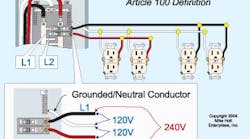All questions and answers are based on the 2005 NEC.
Q. Where in the Code does it say that sharing a neutral is acceptable?
A. Article 100 defines a multiwire branch as two or more ungrounded circuit conductors with a common grounded (neutral) conductor. There must be a voltage potential between the ungrounded conductors and an equal voltage potential from each ungrounded conductor to the grounded (neutral) conductor (Figure).
Multiwire branch circuits offer the advantage of fewer conductors in a raceway, smaller raceway sizing, and a reduction of material and labor costs. In addition, they can reduce circuit voltage drop by as much as 50%. However, because of the dangers associated with multiwire branch circuits, the NEC contains additional requirements to ensure a safe installation. See 210.4, 300.13(B), and 408.41 for more information.
Q. When are bonding bushings required on metal electrical raceways?
A. Bonding bushings are one of the methods that can fulfill the NEC requirements for bonding of service raceways, 277/480V systems, and in hazardous (classified) locations. Here are some details:
-
When a metal service raceway terminates to an enclosure with a ringed knockout, a listed bonding device (such as a bonding wedge or bonding bushing) must bond one end of the service raceway with a bonding jumper sized in accordance with Table 250.66 [250.92(B)(4) and 250.102(C)]. If ringed knockouts are not encountered, you can use a bonding locknut instead of a bonding wedge or bonding bushing.
-
Metal raceways or cables, containing 277V or 480V circuits, terminating at ringed knockouts must be bonded to the metal enclosure with a bonding jumper sized in accordance with Table 250.122, based on the rating of the circuit overcurrent protection device [250.97, 250.102(D)].
-
Because of the explosive conditions associated with electrical installations in hazardous (classified) locations, electrical continuity of the effective ground-fault current path (metal parts of equipment and raceways) must be ensured by one of the methods specified in 250.92(B)(2) through (4). A bonding bushing is one of the acceptable methods [250.100].
Q. When sizing the feeder conductors on the load side of a 1,200A adjustable trip breaker, can the conductors be sized to the 1,100A adjustable long-time trip setting of the circuit breaker?
A. As a general rule, the ampere rating of an adjustable circuit breaker is equal to its maximum long-time pickup current setting, and that maximum would be used for sizing conductors [240.6(B)]. However, if the adjustable-trip circuit breaker has restricted access to the adjusting means, then the ampacity of the conductors can be sized based on the adjusted long-time pickup current settings [240.6(C].
In sizing conductors, remember Sec. 240.4(C) says that if the circuit's overcurrent protection device exceeds 800A, then the conductor ampacity, after ampacity adjustment and/or correction must have a rating not less than the rating of the overcurrent device.
Example: An 1,100A protection device can be used to protect three sets of 500kcmil conductors per phase, where each conductor has an ampacity of 380A at 75°C, in accordance with Table 310.16.
Q. Can I install the meter and service disconnect directly below a window, if it's supplied by an underground service lateral?
A. The Code does not restrict the area below a window for the installation of service equipment. Interestingly, the Code does not specify a minimum mounting height for the service disconnect except the 2-foot minimum for mobile homes [550.32(F)]. It does, however, specify that the maximum height from the center of the grip of the operating handle of a switch or circuit breaker used for service equipment, in its highest position, must not be more than 6 feet 7 inches above the floor or working platform [240.24(A)].
Note: The Code does not define an acceptable height for the meter, but most electric utilities require it to be mounted near eye level. Therefore, check on local requirements that may apply to the meter height.
Q. What are the NEC requirements for the minimum distance that receptacles and switches must be from the bathtub/shower space?
A. According to 406.8(C), receptacles must not be installed within or directly over a bathtub or shower stall, and switches can be located next to, but not within, a bathtub, hydromassage bathtub, or shower space [404.4, 680.70, 680.72].
Note: Switches must be located no less than 5 feet from pools [680.22(C)], outdoor spas and hot tubs [680.40], and indoor spas or hot tubs [680.43(C)]. Receptacles must be located no less than 5 feet from an indoor spa or hot tub [680.43(A)(1)]. Hydromassage bathtubs are treated like bathtubs [680.72].
Q. Does the Code allow the use of single-pole light switches for single line-to-line lighting, or must I use a 2-pole switch?
A. The Code does not have any requirements for the number of conductors needed to be opened to control a single line-to-line load. However, if you are using a circuit breaker for switching, you must use a 2-pole circuit breaker or two individual single-pole circuit breakers with handle ties identified for the purpose [240.20(B)(2)].




